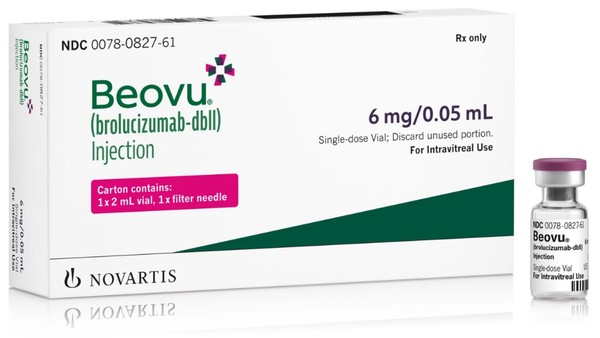Novartis Korea said Beovu (ingredient: brolucizumab), a treatment for wet, age-related macular degeneration (AMD), obtained the Ministry of Food and Drug Safety approval for expanded indication to also treat diabetic macular edema on Aug. 4.

The ministry granted the expanded indication approval based on the results of two phase 3 clinical trials -- KESTREL and KITE -- which directly compared efficacy and safety (head-to-head) to the existing treatment, aflibercept.
The company conducted the clinical trial on 926 patients with type 1 or type 2 diabetes over 18 with impaired vision due to diabetic macular edema (566 from KESTREL and 360 from KITE).
After one year (52 weeks) passed, the Beovu group demonstrated non-inferiority in visual acuity improvement with fewer injections compared to the control group (aflibercept group), controlled retinal exudate in a higher proportion of patients, and showed a central subfield thickness (CTS) of less than 280 µm5.
"With the expansion of Beov's indications to treat diabetic macular edema as well, we are delighted to increase treatment options for people with impaired vision from the disease, following Lucentis," said Cho Yeon-jin, head of Novartis Korea's Ophthalmology and Zolgensma business unit. "Novartis will continue to show leadership in the field of ophthalmic disease treatment and strive to introduce effective and safe treatments to the clinical field continuously."
Beovu is a therapeutic agent that binds to vascular endothelial growth factor-A (VEGF-A) and inhibits neovascularization and retinal exudate leakage.
In the case of use and dosage for the treatment of diabetic macular edema, patients received 6 mg (0.05 mL) for the first five times, once every six weeks, and then once every 12 weeks after that. However, patients with disease activity can receive the treatment once every eight weeks.
Physicians can determine the dosing intervals based on disease activity assessed by visual and/or anatomical criteria.
Diabetic macular edema is a disease that causes macular edema due to an increase in vascular endothelial growth factor and neovascularization resulting from the flow of exudate from damaged microvessels due to the inability to control high blood sugar.
According to a paper published in 2011, diabetic macular edema is the leading cause of blindness in adults in developed countries, affecting 12 percent of patients with type 1 diabetes and 28 percent of patients with type 2 diabetes.

